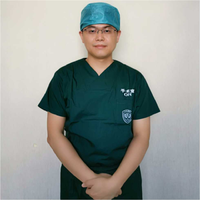 三甲
三甲
AMIC Chondro-Gide软骨基质I/III型胶原纤维支架联合微骨折技术修复膝关节软骨缺损3
AMIC Chondro-Gide 软骨基质I/III型胶原纤维支架联合微骨折技术修复膝关节软骨缺损3
国际软骨再生与关节保留协会




自体基质诱导的软骨再生(AMIC?)
全层软骨损伤,即延伸到软骨下骨的损伤,很少自发愈合,通常需要延长的愈合期。大多数全层软骨病变需要介入治疗,通常是手术治疗。
骨髓刺激技术,例如微骨折(本网站其他地方描述),用于将骨髓干细胞从下层的骨髓基质中释放出来。产生的上层血凝块中含有未分化的软骨细胞前体细胞,称为骨髓间充质干细胞(MSCs),可以帮助软骨再生。上层血凝块覆盖有一层膜,以保护MSC并将它们固定在适当的位置(这是AMIC设计的思路)。受到膜保护的上层血凝块是MSCs分化和生长以及以均匀和功能方式软骨再生的完美环境,在此期间膜可被再吸收。这种新组织最终可以形成透明状软骨,即使在专业运动人士中也能恢复正常活动。
自体基质诱导的软骨再生(AMIC?)是一项首先在德国开发的技术,然后于2000年代初在瑞士率先使用,以帮助治愈软骨损伤。它具有自体软骨细胞植入等技术的一些优点,但避免了软骨细胞的冗长和复杂的体外培养和第二次外科手术的要求。
AMIC?方法可用于承重关节,例如踝关节、膝关节和髋关节,临床研究显示良好的效果,在术后10年及以上有显着功能改善和疗效成功。结合骨移植,AMIC?甚至可用于病变可能涉及相当深度的软骨下骨的严重病例,例如剥离性骨软骨炎(OCD)。
目标受众:本文适用于任何关节软骨受损的人士及其家人,他们想了解自体基质诱导的软骨形成,以及对软骨问题感兴趣的任何人。
什么是自体基质诱导的软骨再生(AMIC?)?
AMIC?是一种修复深层软骨和软骨下骨病变的一步法手术。如果您的外科医生认为AMIC?是您受损软骨的正确治疗方式,您将接受关节手术治疗。这种手术通常在全身麻醉或脊髓麻醉下进行。AMIC?可以通过关节镜或开放式手术进行。在此手术期间,您的外科医生将移除受损的软骨。然后将骨骼进行微骨折或钻孔,以促进受控水平的出血并从骨骼和骨髓中释放骨髓干细胞MSC。这一步称为骨髓刺激术。如果手术在此时停止,这种方法将是标准的微骨折。然而,在AMIC?中,一种特殊设计的猪胶原蛋白膜被切割成完美地贴合在准备好的软骨缺损内,被放置在出血的骨软骨表面上。根据外科医生的偏好、修复的目的和软骨下骨的受累程度,用纤维蛋白胶将其固定到位或在其周围缝合。在膜下,含有骨髓干细胞MSC的受保护上层血凝块随后在骨表面形成。这个由膜的存在建立的生物室有助于身体刺激软骨细胞的生长,并有利于软骨组织的再生。
自体基质诱导软骨再生(AMIC?)的优势是什么?
?AMIC?是一步法手术操作。在实验室培养细胞没有延迟,不需要第二次外科操作。植入物会被身体自然吸收。
?在许多情况下,AMIC?可以通过关节镜微创操作下进行。
?AMIC?是一种成熟的治疗方法,具有持久、长期的效果。10年前接受治疗的患者仍然从治疗中受益,与手术前相比,疼痛减轻且症状更少。
?不适合单独用微骨折处理的大面积软骨缺损可以用AMIC?处理。临床研究表明,在大面积软骨损伤中,AMIC?比单独使用微骨折产生更好的结果。
?AMIC?是一种修复软骨损伤的经济有效的治疗方法。
自体基质诱导软骨再生(AMIC?)的缺点是什么?
AMIC? 不适用于以下患者:
?已知对猪胶原蛋白过敏。
?手术部位的急性或慢性感染。
?急性或慢性炎症性关节病。
并发症:与所有外科手术一样,AMIC? 手术期间可能会出现并发症。
常见问题(FAQ)
AMIC治疗将持续多长时间?
研究表明,长达10年前接受AMIC?的患者仍然表现良好。
我什么时候可以恢复正常活动?
术后康复计划始终由医生制定,没有适用于所有患者的通用指南。在许多情况下,患者能够在手术后的几天内开始在手术关节上部分负重。大约6周后可以尝试完全负重。应逐渐增加活动量,大多数患者应能在6个月内恢复体育活动。
Autologous Matrix-Induced Chondrogenesis (AMIC?)
Full-thickness cartilage damage, that is, damage that extends to the underlying subchondral bone, rarely heals spontaneously and often requires extended healing periods. Most full-depth chondral lesions will require an interventional therapy, usually surgery.
Bone marrow stimulating techniques, such as microfracturing (described elsewhere on this website), are used to free cells from the underlying bone. The resultant super clot contains undifferentiated chondrocyte precursor cells, known as mesenchymal stem cells (MSCs), which can help regenerate cartilage. The super clot is covered with a membrane to protect the MSCs and keep them in place. The super clot, protected by the membrane, is a perfect environment for the differentiation and growth of MSCs and the regeneration of the cartilage in an even and functional manner, during which time the membrane is resorbed. This new tissue can eventually form hyaline-like cartilage, allowing resumption of normal activity even in sport professionals.
Autologous Matrix-Induced Chondrogenesis (AMIC?) is a technique first developed in Germany and then pioneered in Switzerland in the early 2000s to help heal cartilage damage. It has some of the advantages of techniques such as autologous chondrocyte implantation, but avoids the lengthy and complicated in vitro culturing of cartilage cells (chondrocytes) and the requirement for a second surgical procedure.
The AMIC? method can be used in load-bearing joints, such as the ankle, knee and hip, and clinical studies have shown good results with significant improvement and success out to and beyond 10 years post-surgery. In combination with bone grafting, AMIC? can even be used in severe cases where a lesion may involve the subchondral bone to a considerable depth, such as osteochondritis dissecans (OCD).
Intended audience
This article is intended for anyone suffering from damage to their articular cartilage and their families who would like to find out about autologous matrix-induced chondrogenesis, as well as anyone interested in cartilage problems.
What is Autologous Matrix-Induced Chondrogenesis (AMIC?)?
AMIC? is a single-step surgery to repair deep chondral and subchondral lesions. If your surgeon considers that AMIC? is the correct treatment procedure for your injury, you will undergo surgery on your joint. This surgery is usually performed under general or spinal anaesthetic. AMIC? may be performed arthroscopically or in an open surgery.
During this surgery, your surgeon will remove the damaged cartilage. The bone will then be microfractured, or drilled, to encourage a controlled level of bleeding and to release MSCs from the bone and bone marrow. This step is called bone marrow stimulation.
If the surgery were to stop at this point, this approach would be standard microfracture. However, in AMIC?, a specially designed porcine collagen membrane, cut to fit perfectly within the prepared chondral defect, is placed over the bleeding bone surface. It is held in place with fibrin glue or is sutured around its periphery, depending upon surgeon preference, the intent of the repair, and the level of involvement of the subchondral bone.
Under the membrane a protected super clot containing MSCs then forms on the bone surface. This biological chamber, established by the presence of the membrane, helps the body to stimulate chondrocyte growth and is conducive to the regeneration of cartilage tissue.
Figures
AMIC
What are the advantages and disadvantages of Autologous Matrix-Induced Chondrogenesis (AMIC?)?
What are the advantages of Autologous Matrix-Induced Chondrogenesis (AMIC?)?
· AMIC? is a one-step procedure. There is no delay while cells are cultured in a laboratory, and no second operation is needed. The implant is naturally resorbed by the body.
· AMIC? can be performed arthroscopically in many cases.
· AMIC? is an established treatment with durable, long-term results. Patients who were treated up to 10 years ago are still benefitting from the treatment, with reduced pain and fewer symptoms compared with before the surgery.
· Large defects which are not suitable for treatment with microfracture alone can be treated with AMIC?. Clinical studies have shown that AMIC? results in better outcomes than microfracture alone in large cartilage lesions.
· AMIC? is a cost-effective treatment for repairing cartilage lesions.
What are the disadvantages of Autologous Matrix-Induced Chondrogenesis (AMIC?)?
AMIC? should not be used in patients with:
· a known allergy to porcine collagen
· acute or chronic infection at surgical site
· acute or chronic inflammatory joint disease
Complications:
As with all surgical procedures, complications can occur during the AMIC? procedure.
Frequently Asked Questions (FAQs)
How long will the AMIC treatment last?
Studies have shown that patients who underwent AMIC? up to 10 years ago are still doing well.
When can I resume my normal activities?
The rehabilitation program is always customized by the physician, there are no general guidelines that can be applied to all patients. In many cases patients are able to begin partial weight bearing on the operated joint within a few days of surgery. Full weight bearing can be attempted after approximately 6 weeks. Activity should be increased gradually, and most patients should be able to resume sporting activities within 6 months.
进一步阅读
Further reading
There have been a number of studies evaluating the outcomes of AMIC?. Some key papers are listed below:
· Kaiser N, Jacobi M, Kusano T, Jakob R, Gautier E, Petek D. Clinical results 10 years after AMIC in the knee. Swiss Med Wkly 2015;145(Suppl. 219): FM145.
· Kusano T, Jakob RP, Gautier E, Magnussen RA, Hoogewoud H, Jacobi M. Treatment of isolated chondral and osteochondral defects in the knee by autologous matrix-induced chondrogenesis. Knee Surg Sports Traumatol Arthrosc 2012;20:2109–15.
· Lee YHD, Suzer F, Thermann H. Autologous matrix-induced chondrogenesis in the knee: A review. Cartilage 2014;5:145–53.
· Wiewiorski M, Werner L, Paul J, Anderson AE, Barg A, Valderrabano V. Sports activity after reconstruction of osteochondral lesions of the talus with autologous spongiosa grafts and autologous matrix-induced chondrogenesis. Am J Sports Med 2016;44:2651–8.
· Volz M, Schaumburger J, Frick H, Grifka J, Anders S. A randomized controlled trial demonstrating sustained benefit of autologous matrix-induced chondrogenesis over microfracture at five years. Int Orthop 2017;41:797–804.
Keywords
AMIC, autologous matrix-induced chondrogenesis, Cartilage
图片与文字来源ICRS: https://cartilage.org/patient/about-cartilage/cartilage-repair/amic/
Autologous Matrix-Induced Chondrogenesis (AMIC?) | Patient Education (cartilage.org).
本文是陶可版权所有,未经授权请勿转载。本文仅供健康科普使用,不能做为诊断、治疗的依据,请谨慎参阅






评论